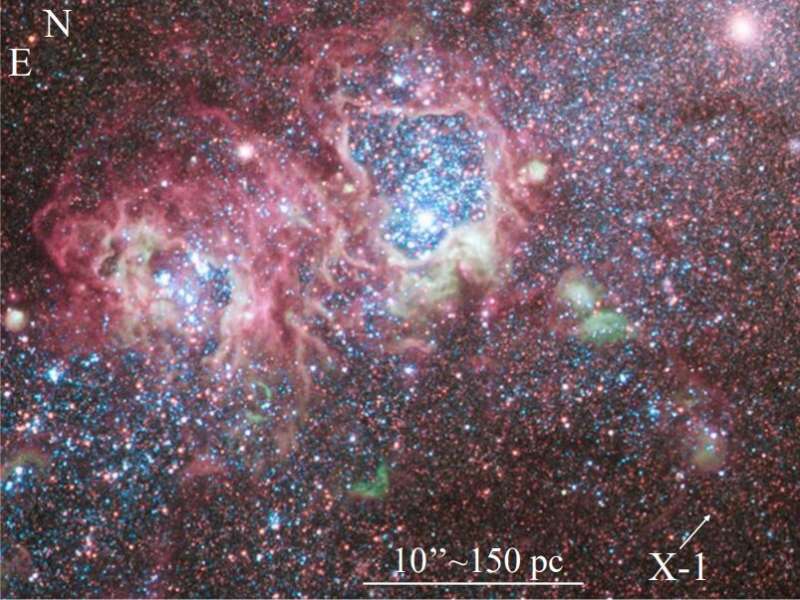July 24, 2023 report
This article has been reviewed according to Science X's editorial process and policies. Editors have highlighted the following attributes while ensuring the content's credibility:
fact-checked
preprint
trusted source
proofread
Observers investigate a short-period X-ray binary system

Using the Hubble Space Telescope (HST) and the Chandra X-ray Observatory, astronomers have taken a closer look at a short-period high-mass X-ray binary known as CXOU J121538.2+361921. Results of the observational campaign, presented July 13 on the preprint server arXiv, shed more light on the properties of this system.
X-ray binaries are composed of a normal star or a white dwarf transferring mass onto a compact neutron star or a black hole. Based on the mass of the companion star, astronomers divide them into low-mass X-ray binaries (LMXBs) and high-mass X-ray binaries (HMXBs).
Located some 9.8 million light years in the galaxy NGC 4214, CXOU J121538.2+361921 (or NGC 4214 X-1) is a luminous HMXB, showcasing X-ray eclipses with a period of 3.62 hours. The eclipse period is, most likely, also the orbital period, which makes NGC 4214 X-1 the shortest-period HMXB system known to date. However, although many studies of this system have been conducted, its properties are not well understood.
That is why a team of astronomers led by Zikun Lin of the University of Chinese Academy of Sciences in Beijing, China, decided to investigate NGC 4214 X-1 with Hubble and Chandra telescopes.
"We combined new and archival Chandra and HST data for a study of the short-period, eclipsing X-ray binary NGC 4214 X-1," the researchers wrote in the paper.
The observations confirmed that NGC 4214 X-1 is still active and still showcasing eclipses, with an out-of-eclipse luminosity at a level of about one duodecillion erg/s. The eclipse period and the average eclipse duration time were confirmed to be approximately 3.6 and 0.57 hours, respectively.
The eclipse fraction was calculated to be about 0.16, which allowed the researchers to estimate the minimum mass ratio of the system—approximately 2.0. This finding further confirms the HMXB nature of NGC 4214 X-1.
The stellar density of the donor star was calculated to be approximately 5.9 g/cm3. This result, together with the mass ratio and short binary period, suggest that the donor is a Wolf-Rayet (WR) star or an intermediate-mass stripped helium star.
Moreover, based on HST observations, Lin's team found an optical counterpart to NGC 4214 X-1, with an apparent brightness of 24 mag. The optical source consists of two clearly distinct components: a blue emitter (with a temperature of about 60,000–80,000 K and characteristic radius of 2.0 solar radii) and a red emitter (with a temperature of about 2,500–3,000 K and characteristic radius of some 400 solar radii).
The authors of the paper concluded that the blue component further supports the WR scenario for the donor star in NGC 4214 X-1. They added that the red component may be an irradiated circumbinary disk.
More information: Zikun Lin et al, On the Short-Period Eclipsing High-Mass X-ray Binary in NGC 4214, arXiv (2023). DOI: 10.48550/arxiv.2307.06993
Journal information: arXiv
© 2023 Science X Network





















